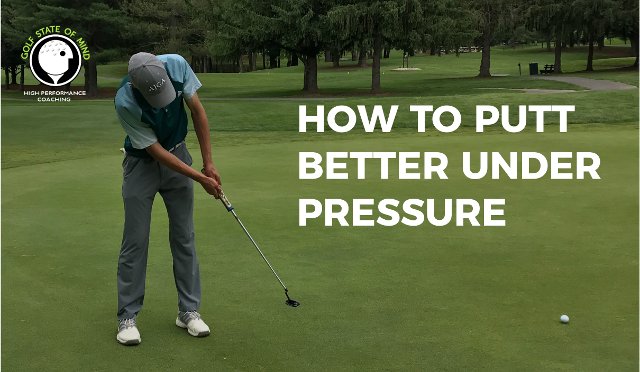
It’s one thing to be a great putter in practice, but it’s another to do it when the pressure’s on, during a tournament. In this article I’m going to show you ways that you can putt better under pressure.
How To Putt Under Pressure
In order to putt better under pressure and take your practice game into a tournament, we need to figure out what changes between the 2 environments.
What happens as a result of pressure?
- Your heart rate increases
- There’s tension in your muscles (grip pressure increases)
- You’re not able to think as clearly during your routine
- There’s “thinking” while you’re over the ball: “Don’t miss it” or “If I can just make this one…”
But, it doesn’t have to be this way. With simple techniques, you can learn how to putt better under pressure.
I’ve spent the last ten years working with players to put together bullet proof routines and help them with mental training, so they can actually putt better under pressure, than they do in practice.
How do we do it?
When you’re feeling pressure on the course, it’s because you’ve become too consequence or outcome focused. On the practice green, or during casual rounds, you’re simply focusing on the proper steps (your process) and the intention for the putt (not the consequence of it). Your mind is quiet. Once the line and the pace has been determined, you make your stroke without any conscious thought.
Where to put your focus to putt better under pressure
On the course, golf is a harder game than most due to the amount of time that you’re not playing. 90% of a round is spent in between shots. This give you over 3 hours out of a 4 hour round of golf to think about how you’re playing, why you’re not playing well, what you might shoot etc.
All these thoughts cause “performance anxiety”, which manifests itself in those symptoms listed above. The product of this is under-performance. I.e. if you’re waiting for your turn on the green, thinking about what it’s going to mean to make or miss the putt in front of you, you’re going to decrease your chances of making it.
When you’re playing other sports, such as soccer, basketball and tennis, most of time you’re simply reacting to what’s happening in the game, so it’s easier to access your skills subconsciously (without “thinking”). This makes the athletic movement more fluid instead of being interfered with by conscious thought and “over-thinking”.
Make process the goal to putt better under pressure
The 3 main goals for my students for any round is: Process, Presence and Acceptance.
1. Process
If you make process the goal for every shot (and hold yourself accountable to it with a mental game scorecard), it ensures you’re doing the things you need to be doing to maximize your chances of success. The sequence should be fairly consistent every time, down to the number of seconds spent at address. You don’t want to be staring down at the ball for too long – this causes “visual decay” which disconnects you from the target/intention. The athletic mind needs to be fully engaged to keep the stroke as fluid as possible.
Here’s one pre shot routine option (there are many) to keep your conscious mind occupied and your athletic mind free to make the stroke:
- Make a look down the line to the hole to the count of “1”
- Glance back at the ball to the count of “2”
- Make your back-stroke to the count of “3”
- Make your forward-stroke to the count of “4”
- Look up to see where the putt to the count of “5”
So the whole putting action takes about 5 seconds.
Process focus is the opposite of outcome focus. All my players make a good “process score” the goal for a round, not shooting a good score. This keeps them focused on what they can control (their process), instead of what they can’t fully control (their score). This lowers performance anxiety and makes a low score more possible.
What the process needs to be is player specific, and your optimal pre shot routine can be determined via my mental game training system.
2. Present
Being present during a round of golf is hugely important, especially to putt better under pressure. When you are present, your mind is quiet and your body is tension free. Compare that to over-thinking what just happened or what might happen in the future.
All my students practice being present on and off the course.
3. Acceptance
Acceptance of negative outcomes is an absolute must in golf. We all make mistakes (Tour players included) and we all hit bad shots from time to time. Being accepting and self-compassionate on the course (not beating yourself up) is another measure of success that I hold my students accountable to.
Make these your 3 goals for the round, instead of focusing on the results, and you’ll no doubt putt better under pressure and see more success in tournaments.

